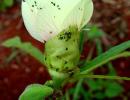 |
Okra
Scientific name:
Abelmoschus esculentus
Family:
Malvales: Malvaceae
Local names:
Ghana: Okro; Swahili: Bamia, Binda
Pests and Diseases: African bollworm
Aphids
Bacterial blight
Black mould
Cotton seed bugs
Cotton stainers
Cutworms
Damping-off diseases
Early blight
Flea beetles
Flower or blister beetles
Fusarium wilt
Grasshoppers
Leafmining flies (leafminers)
Powdery mildew
Root-knot nematodes
Semiloopers
Spider mites
Spiny bollworm
Stink bugs
Thrips
Whiteflies
Early blight
|
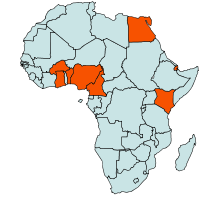 |
| Geographical Distribution of Okra in Africa |
Okra, also called lady's fingers, is mainly grown for its young immature pods, which are consumed as a vegetable, raw, cooked or fried. It is a common ingredient of soups and sauces. The pods can be conserved by drying or pickling. The leaves are sometimes used as spinach or cattle feed, the fibres from the stem for cord, the plant mucilage (thick gluey substance) for medical and industrial purposes, and the seeds as a substitute for coffee. Okra seeds contain a considerable amount of good quality oil and protein.
Nutritive Value per 100 g of edible Portion
| Raw or Cooked Okra | Food Energy (Calories / %Daily Value*) |
Carbohydrates (g / %DV) |
Fat (g / %DV) |
Protein (g / %DV) |
Calcium (g / %DV) |
Phosphorus (mg / %DV) |
Iron (mg / %DV) |
Potassium (mg / %DV) |
Vitamin A (I.U) |
Vitamin C (I.U) |
Vitamin B 6 (I.U) |
Vitamin B 12 (I.U) |
Thiamine (mg / %DV) |
Riboflavin (mg / %DV) |
Ash (g / %DV) |
| Okra cooked | 22.0 / 1% | 4.9 / 2% | 0.2 / 0% | 1.9 / 4% | 77.0 / 8% | 32.0 / 3% | 0.3 / 2% | 135.0 / 4% | 283 IU / 6% | 16.3 / 27% | 0.2 / 9% | 0.0 / 0% | 0.1 / 9% | 0.1 / 3% | 0.8 |
| Okra raw | 31.0 / 2% | 7.0 / 2% | 0.1 / 0% | 2.0 / 4% | 81.0 / 8% | 63.0 / 6% | 0.8 / 4% | 303 / 9% | 375 IU / 7% | 21.1 / 35% | 0.2 / 11% | 0.0 / 0% | 0.2 / 13% | 0.1 / 4% | 0.7 |
Okra will grow on a wide range of soils, but it prefers soils high in organic matter. When grown in sandy soils, it must be frequently fertilised, as soluble nutrients readily leach from the root zone. Its optimum range of soil pH is between 5.8 and 6.5. A soil test will indicate if lime is required to adjust the pH and the amount to apply. If lime is recommended, dolomite should be used, applied 3 to 4 months before the crop is seeded. Okra is sensitive to salinity.
Okra can grow in a wide range of rainfall regimes, but needs 400 mm of water for the growing period of about 3 months.
-
"Pusa sawani"
High yielding variety tolerant to vein mosaic. It grows 2 to 2,5 m tall, has long pods. (18 to 20 cm), dark green, smooth and has 5 ridges. Mainly for export. -
"Clemson spineless"
1.2 to 1.5 m tall. Pods are about 15 cm long, green and moderately ridged. -
"Green Emerald2
This variety is about 1.5 m tall. Pods are 18 to 20 cm long slightly ridged (rounded) and green. -
"White velvet"
A medium tall variety of 1.5 to 1.8 m high. Pods are 15 to 18 cm long, slender, tapered, smooth and creamy white. -
"Dwarf Green Long Pod"
It grows up to 0.9 m high. It has several side branches. The pods are angular and green and about 18 to 20 cm long.
Land preparation
Thorough soil preparation 2 to 3 months before planting is recommended to allow crop residues and organic matter in the soil to decompose before okra is planted. Early land preparation also permits weed seeds to germinate and allows early cultivation to destroy young weeds before planting.
Planting
Okra plants may be established by direct seeding in the field, by growing seedlings in nursery seedbeds or by raising seedlings in plastic trays. To facilitate speedy germination, okra seed should be soaked in water overnight before planting. In Kenya, okra is sown directly in the field. About 8 to 10 kg of seed is required per hectare. Planting depth is about 1.5 cm. Spacing varies: 45x45 cm, 50x30 cm or 60x15 cm between the rows and within the rows, respectively. In some parts of Kenya, okra is planted 2x2 m in flood irrigationed basins. The main export season in Kenya is October to May; hence planting should start from July so as to target this export season. However with irrigation okra can be grown all year round for the local and off-season export markets.
Fertilisation
It is recommended that soil be analysed before okra planting to determine fertility treatment needed. Without a soil test, the general recommendation in Kenya (issued by Horticultural Crops Development Authority) for conventional production (non-organic production) is as follows: well-composted manure should be applied at planting at the rate of 15 to 20 t/ha (17 to 20 gm/plant). It should be mixed thoroughly with the soil in the planting hole. Also, during planting, fertiliser (NPK 17:17:17) is recommended at the rate of 120 kg/ha (two gm/plant). The fertiliser should be applied in bands on the side of the furrow where the seeds will be planted and mixed well with the soil.
The plants should be top dressed using 140 kg of CAN (calcium ammonium nitrate) /ha spilt in two applications. The first application at the rate of 70 kg/ha (68 gm/plant) should be done 3-4 weeks after planting and the second application 3 to 4 weeks later. However, CAN should be applied only in soils with acid or neutral soil pH (pH smaller or equal to 7.0). In alkaline soils (ph greater or equal to 7.0) sulphate of ammonia (SA) should be used instead at the rate of 87 kg/ha (85 gm/plant). Urea is an alternative to CAN but it should be applied only in moist soils at the rate of 40 gm per plant. It should not be applied in soils with a pH 8 or higher as high volatilisation of ammonia would occur. Applying NPK (17:17:17) at flowering is recommended, at the same rate as at planting to boost flowering and pod production. Fertilisers containing chlorides should be avoided, since okra is sensitive to salinity.
Sources of plant nutrients
In organic management we have to rely on the natural sources of plant nutrients such as compost, manure teas, plant teas such as tithonia for foliar feed. Well-composted manure should be applied at planting at the rate of 15 to 20 t/ha (17 to 20 gm/plant). Additional compost or manure is needed during the vegetation period. Manure and plant teas can be fed to the plants via a drip irrigation system to avoid excessive labour. However on acid soils agricultural lime is recommended and allowed. Also Mijingu (rock phosphate) is recommended on soils low in phosphorous (almost all soils in Kenya).
Irrigation
Okra is a heavily foliaged crop, so its water requirements are high. According to the Kenya Ministry of Agriculture okra needs 400 mm of water during the growing season of three months. A general guideline for semi-arid areas, where okra is mostly grown in Kenya, is to provide about 35 mm of water per week (this equals 35 litres of water per square metre). Critical times for irrigating okra are at emergence and from flowering to pod production. Saline or chlorinated water should not be used for irrigation.
Rotation
Okra should be rotated with baby corn, maize, peas, onions, potatoes, fodder grass or small grains. Being in the same family as cotton - with which it shares the same complex of pests and diseases - okra should not be grown before or after cotton.
Weed control
Okra is harvested over a long period and weed control is important throughout the cropping season. Smallholder growers in Kenya control weeds by hand hoeing.
Harvesting is done by hand. The pods can be snapped off or cut off, leaving a small stalk not longer than one cm. The pods must be handled carefully otherwise they may be bruised and may discolour. It is best to pick pods into a waist bag to reduce skin damage and to avoid excessive bending of the pods. Wearing rubber gloves when harvesting and handling pods is recommended. This will protect the skin from irritating sap produced by okra plant.
Cutworms (Agrotis spp.)
Cutworms are the caterpillars of some moths. They destroy whole plants by girdling and cutting off young seedlings at the soil level during the night. They hide in the soil during the day.
- Plough field and remove weeds well ahead of planting the crop in the field. Ploughing exposes caterpillars to predators and to desiccation by the sun. If the field is planted soon after land preparation some cutworms may be alive and attack the new crop.
- Inspect soil carefully for the presence of cutworms when preparing land for planting.
- Make barriers to protect seedlings. Barriers can be made by wrapping paper, aluminium foil, thin cardboard, or similar materials around the base of young plant stems. Toilet rolls are handy as cutworm collars since they are readily available and will biodegrade into the soil.
- Monitor damage by counting damaged and freshly cut young plants.
- Collect and destroy cutworms. Cutworms are found in the soil close to damaged plants at daytime. Check for cutworms at dawn.
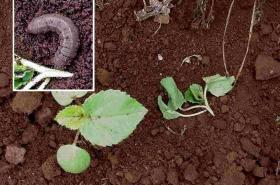
Okra seedling damaged by cutworm (Agrotis spp.) caterpillar (right). Note healthy seedling on the left. Close-up of cutworm (inset)
© A.M. Varela, icipe
Cotton seed bugs (Oxycarenus spp.)
They feed on developing pods. These bugs are small (4 to 6 mm), and blackish in colour. Their wings are transparent. They attack open or damaged pods mainly at the end of the growing season. Nymphs and adults suck from immature seeds, preventing them from ripening. Groups of bugs are usually found between flower buds, flowers and pods. These bugs are minor pests of okra and usually no control measures are needed.
- No control is recommended since they are minor pests.
- Dislodge the bugs by shaking the plants.
- Control measures for cotton stainers are usually effective against cotton seed bugs.
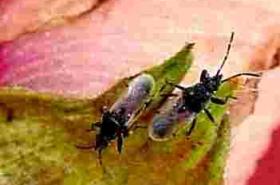
Cotton seed bugs (Oxycarenus sp.) on okra, these bugs are small (4 to 6 mm)
© A. M. Varela, icipe
African bollworm (Helicoverpa armigera)
The African bollworm feeds on leaves, flowers and pods of okra. The main damage occurs on flowers and pods. Attack on flowers results in flower abortion. The caterpillar usually bore clean, circular holes in pods, causing extensive damage and promoting decay from secondary infection by diseases.
- Conserve natural enemies. The African bollworm has a wide variety of natural enemies. Parasitic wasps and predators such as ants, lacewings, and ladybird beetles are important in natural control of this pest.
- Inspect plants regularly; once or twice a week after plants begins to bloom. Early detection of eggs and/or caterpillars before they bore into the pods is important.
- Hand pick and destroy eggs and caterpillars. This helps when their numbers are low and in small fields.
- If necessary, spray with Bt or neem extracts. Good spray coverage and targeting small caterpillars before they bore into the pods is very important. For more information on neem click here. For information on Bt click here
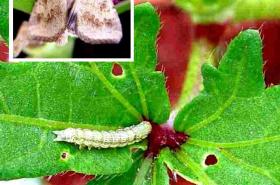
Young caterpillar of African bollworm (Helicoverpa armigera) feeding on okra leaf and a moth (inset). Fully-grown caterpillars are 35 - 40mm long.
© A.M. Varela, icipe
The spiny bollworm or spotted bollworm (Earias spp.)
It is a major pest of okra. The full grown larva is 13-18 mm long and 2.5 mm wide. It is stout and spindle shaped. The body colour is variable, ranging from greyish-brown, through grey to green, with a distinctly paler or white median line. The adult is a moth, about 12 mm long with a wingspan of about 20-22 mm. The forewings (front wings) are white, peach, metallic green to straw yellow in colour according to the species.
The larvae/caterpillars bore into terminal shoots of young plants, causing death of the tip and development of side shoots. When pod production starts, the caterpillars move to the flower buds, small pods and eventually mature pods. Damaged flower buds and young pods are shed, leading to yield reduction. Damaged pods ad pods contaminated with insect frass are not marketable. High doses of nitrogen fertilisers have been found to increase spiny bollworm infestation.
- Scout the crop regularly. Early detection of eggs and/or caterpillars before they bore into the pods is important.
- Conserve of natural enemies.
- Hand pick and destroy eggs and caterpillars, and damaged tips and pods (in small plots).
- Regulate fertilisation. Avoid high doses of nitrogen.
- Destroy old crops and crop debris after harvesting.
- Use biopesticides (e.g Bt, neem-based pesticides). Good spray coverage and targeting small caterpillars before they bore into the pods is very important.
For information on Bt click here.. For information on neem click here.
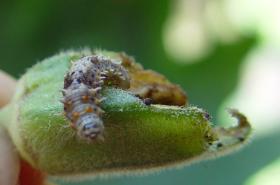
Young okra pods damaged by caterpillar of the spiny bollworm (Earias spp.). The full grown larva is 13-18 mm long and 2.5mm wide. It is stout and spindle shaped. The body colour is variable, ranging from greyish-brown, through grey to green, with a distinctly paler or white median line.
© A.M. Varela, icipe
Spider mites (Tetranychus spp.)
Spider mites suck the sap of plant tissues. Infested leaves first show a white to yellow speckling and then turn pale or a reddish bronze colour as infestation becomes heavy. The leaves curl up under severe attack and finally wither and fall off, leading to plant defoliation. In severe infestation, spider mites will also attack pods, causing pod contamination. Major factors leading to spider mite outbreaks are very hot and dry conditions, destruction of natural enemies and the presence of other highly infested crops (e.g. cotton tomato) in the vicinity of the okra crop.
- Monitor regularly the crop to determine the presence and level of infestations of spider mites.
- Conserve natural enemies. A number of predators are known to feed on spider mites. They usually keep spider mites under control provided no broad-spectrum pesticides are applied and the crop is irrigated properly.
- Keep field free of weeds and destroy or compost crop residues immediately after harvesting. Crop residues from an infested field should be destroyed.
- Do not plant a new crop near an infested field.
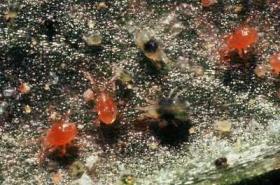
The predatory mite (Phytoseiulus persimilis) (orange-red individuals), in a colony of two-spotted spider mite (Tetranychus urticae). Two-spotted spider mite adult females are 0.6 mm long.
© Image supplied by Warwick HRI, University of Warwick.
Thrips (Frankliniella spp.)
Thrips feed on the lower surface of leaves, flowers and fruits. Both larvae and adults puncture the leaves and suck the exuding sap. Heavily attacked leaves become curled, wrinkled and finally dry up. Any environmental stress that weakens the plants makes them more susceptible to thrips attack. Thrips attack on seedlings and young plants delays crop development. Feeding on the flowers may result in deformed pods. Attack on fruits may scar them. Affected fruits are not marketable.
- Conserve natural enemies. In particular predators (e.g. predatory bugs, mites and thrips) are important in natural control of thrips.
- Plough and harrow before planting. This exposes pupae in the soil to natural enemies and desiccation.
- If necessary, spray biopesticides. Spinosad, a bacterium metabolite, is effective in controlling thrips. Insecticides should only be used up to the early flowering stage. Spraying after flowering or a later stage may lead to pesticide residues on the pods. Observe preharvest intervals.
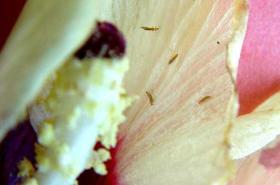
Thrips (Frankliniella spp.) on okra flower. Thrips are small (usually 1 to 2 mm), slender and usually winged.
© A.M. Varela, icipe
The tobacco whitefly (Bemisia tabaci)
Adults and nymphs of the tobacco whitefly suck sap from leaves of okra plants. Attacked plants have low vigour and may wilt, turn yellow and die if whitefly infestations are severe or of long duration. Damage may be accentuated when plants suffer water stress. Whiteflies excrete honeydew on which supports sooty mould growth. This mould may cover the leaves during heavy infestation, and as a result the leaves may turn black, affecting photosynthesis.
- Conserve natural enemies. Parasitic wasps, and predators (predatory mites, lacewings and ladybird beetles) are important in natural control of whiteflies.
- If necessary, spray neem extracts. Neem products inhibit growth and development of immature stages, repel whitefly adults and reduce egg laying. Other substances reported to be effective against whiteflies are soap and water solutions and mineral oils. The amount of soap needed depends on the soap type.
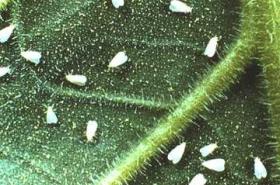
Whiteflies under leaf. Adult whiteflies are about 1mm long.
© Clemson University, Department of Entomology
Root-knot nematodes (Meloidogyne spp.)
The nematodes are soil inhabitants. They attack a wide range of crops, particularly vegetables. Their infestation is most serious in light sandy soils and in furrow irrigated fields. Diseased plants are stunted, yellow and have a tendency to wilt in hot weather. Diseased plants appear in patches in the field. The roots of diseased plants have small lumps known as galls or root knots.
- Use tolerant/resistant varieties.
- Rotate okra with onions, baby corn, maize, millet, sorghum, sesame or Sudan grass.
- Maintain high levels of organic matter in the soil.
- Mix crop with marigold (Tagetes spp.) or Indian mustard.
- Remove crop debris from the field.
- Incorporate neem cake powder into the soil. Neem products are commercially available in Kenya and these products can be used for control of root-knot nematodes.
- Use biofumigation where possible. When growing okra in nematode infested fields intercrop with different mustards (e.g. Brassica juncea var. integrifolia or Brassica juncea var. juncea). As soon as mustards are flowering they are mulched and incorporated into the soil. While incorporated plant parts are decomposing in a moist soil, nematicidal compounds of this decomposing process do kill nematodes. Two weeks after incorporating plant material into the soil a new crop can be planted or sown (phytotoxic effects are usual if the crop is planted before two weeks). For more information on biofumigation click here.
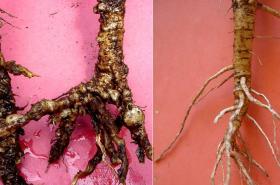
Okra roots damaged by root-knot nematodes. Note gall or root-knots (left) and healthy roots (right).
© A.M. Varela, icipe
Aphids (Aphis gossypii)
The cotton aphid (Aphis gossypii), have been identified as one of the major pest problems of okra in Kenya. They cause damage by sucking plant sap weakening the plants, and by excreting a sticky substance (honeydew), which results in growth of sooty mould affecting photosynthesis. Contamination of pods with aphids, aphid skins, honeydew and/ or sooty mould may result in their rejection in the market.
The cotton aphid transmits the Yellow Vein Mosaic Virus in okra. Cotton aphid (Aphis gossypii) is a small aphid. Adults range from just under 1-1.5 mm in body length.
- Conserve natural enemies. Parasitic wasps and predatory insects, including lady bird beetles, damsel bugs, lacewings, and hover fly larvae are important in natural control of aphids. Link to natural enemies datasheet.
- Use reflective mulches. Reflective aluminium mulches deter aphids from landing on plants. The effect is lost once plants are large enough to cover the mulch.
- Monitor the crop regularly.
- If necessary, spray with botanicals (e.g. neem extracts). Experiments in Kenya showed that neem-based pesticides, namely Achook© (Azadirachtin 15% w/w) and a neem extract (Azadirachtin 0.6 w/w) effectively controlled the cotton aphid giving protection to the crop for the whole season. Yield of plants treated with these two products was similar, but using Achook© was much economic that using the neem extract (Malenge, 2005).
- Spray only attacked plants (spot spraying).

Cotton aphid on flower. Cotton aphid (Aphis gossypii) is a small aphid. Adults range from just under 1-1.5 mm in body length.
© A.M. Varela, icipe
Flea beetles (Nisostra spp., Podagrica spp.)
These are common pests of okra. They are tiny to small beetles, with enlarged hind legs that enable them to jump long distances when disturbed. The colour of the adult beetles varies from black, brown, black and yellow striped or metallic blue-green depending on the species. The adults feed on cotyledons, stems and leaves. They make many small holes on okra leaves, known as "shot-holes". Larvae of flea beetles live in the soil and feed on okra roots, but the damage caused is not of economic importance. Flea beetles are particularly damaging to young plants. Seedlings may wilt and die under heavy flea beetle attack or may stunt if injury is not severe. Damage to cotyledons and young leaves is the major cause of crop loss, generally leading to uneven crop stand. When large numbers of flea beetles are present they will also feed on flower buds and pods, causing yield loss by injuring the pods. Damaged pods are not marketable. Some species of flea beetles are reported to transmit the Okra Mosaic Virus in West Africa.
- Rock powders and clay minerals have a repellent effect on adult flee beetles.
- Treat plants with pyrethrum extracts. They kill adults and larvae. For more information on pyrethrum click here.
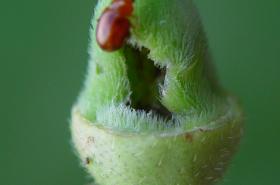
Flea beetle feeding on young okra pod
© A.M. Varela, icipe
Grasshoppers
Grasshoppers are long, slender, winged insects with powerful hind legs and strong mandibles, or mouthparts, adapted for chewing. They range from 1-10 cm in length. They have a front pair of rigid wings and a hind pair of larger, membranous wings, often brightly coloured. When the wings are at rest, the hind pair folds and is covered by the front pair. The rear legs are well developed and usually have sharp spines. Grasshoppers are variable colour; but many are green or brown.
Many grasshoppers lay eggs in pods in the ground, preferably in bare soil; others lay eggs in plant tissue or in crevices. Immature stages are similar to adults but have shorts or no wings. Some grasshoppers have short antenna (short-horned) and other long antenna (long-horned). Grasshoppers can jump well and most of them can fly long distances.
Most grasshoppers are plant-eaters, but some long-horned grasshoppers are predatory with spiny front legs adapted for grasping prey. Grasshoppers feed on okra, eating chunks from the leaves, and stems of young shoots. They can be a problem at the seedling stage, but usually they do not cause damage to older plants.
- Catch grasshoppers by hand or with a butterfly net. Catching them in the early morning is easier, as they are less active in the mornings.
- Conserve natural enemies. Avoid destroying larvae of blister beetles, since they feed on eggs of grasshoppers. Other natural enemies include ants, parasitic flies, assassin bugs, predatory wasps, birds, lizards, snakes, frogs, and fungi. Robber flies are a major predator of grasshoppers. For more information on natural enemies click here
- Domesticated poultry (e.g. chickens, turkeys, guinea fowl, geese, and ducks) and wild birds are good for keeping grasshopper populations in check. They feed on them and dig up their eggs in patches of bare soil. However, birds may damage the plants too. To avoid this enclose the birds in wire fencing along the perimeter so that they can prey on visiting grasshoppers while staying out of the crop.
- Ensure the ground is covered with crops, grass or mulch. This is reported to reduce grasshopper numbers since they prefer laying eggs on bare soil.
- If necessary spray with neem extracts. Neem acts as antifeedant (grasshoppers stop feeding when exposed to neem products) and affects development of the grasshoppers. I For more information on neem click here
- Locate and dig egg-laying sites to expose and destroy the eggs before they start to hatch early in the dry season. However, egg destruction has to be done over a wide area in the wet season in order to be effective. This will require participation of farmers on many neighbouring farms. If only one neighbour destroys the eggs in his/her farm, the grasshoppers will later invade the farm from the neighbouring farms and bushes.
- When available, use biopesticides. IITA researchers and partners have developed an environmental friendly biopesticide "Green Muscle®". It is based on a naturally occurring fungus strain indigenous to Africa (Metarhizium anisopliae) which is deadly to locusts and grasshoppers but reportedly does not harm other insects, plants, animals, or people. Typically 70 to 100% mortality rates were obtained after 8 to 28 days of application ( www.iita.org). The bioinsecticide "Green Muscle®" is effective in grasshopper management in outbreak situations. However, it is costly and currently, it is only available in South Africa and West Africa.
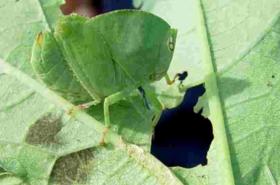
feeding on okra leaf
© A.M. Varela, icipe
Leafmining flies (Liriomyza spp.)
Leafmining flies are common pests of okra in Kenya. Mining of leaves by larvae may reduce photosynthetic activity, affecting development of flowers and pods. In severe infestation, the leaves might be completely mined. As a result the leaves dry and fall off prematurely, causing loss of vigour and turgidity in the plant. This may eventually result in plant wilting.
- Check the seedlings and older plants regularly.
- Conserve natural enemies. Parasitic wasps, in particular, usually keep leafminers under control. However, the indiscriminate use of pesticides disrupts the natural control resulting in leafminer. outbreaks
- Spray neem extracts.
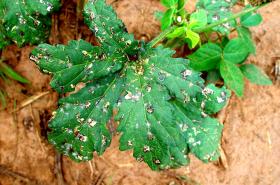
Okra leaf severely damaged by leafminer (Liriomyza spp.) larvae
© A. M. Varela, icipe
Semiloopers (Anomis flava) and Leafrollers (Haritalodes derogata)
Various species of caterpillars feed on okra leaves. Semiloopers chew irregular holes on leaves, giving them a ragged appearance. Other caterpillars feed on the lower leaf surface leaving the upper surface intact (this type of damage is known as windowing). Leafrollers spin or roll leaves together, and eat the leaf margins, causing the leaves to curl and droop. Leaf-eating caterpillars cause economic damage only when present in large numbers, especially in young or stressed plants. Well-established, healthy plants can tolerate considerable loss of leaves; however, seedlings may be killed by severe defoliation.
H. derogata larvae are creamy-white or pale yellow, but appear to be green, owing to ingested leaves in the gut. First-instar larvae are 2 mm long and grow to 22-26 mm long. The larvae have dark-brown heads. The adult is a moth with wingspan of 30-40 mm.
- Check plant, particularly seedlings, regularly and hand pick the caterpillars.
- Spray Bt products. In case of serious attack. Bt var.kurstaki and Bt var. aizawai effective when used against young caterpillars. For more information on Bt click here
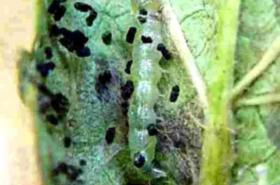
Caterpillar of the leafroller (Haritalodes derogata) on okra leaf. The size is from 3mm to 2.6cm.
© A. M. Varela, icipe.
Flower beetles (Mylabris spp. and Coryna spp.)
Flower beetles are also known as pollen beetles or blister beetles. Adult beetles feed on flowers reducing pod set. They also feed on foliage biting off irregular patches on leaves. Larvae of these beetles do not feed on plants but on eggs of grasshoppers and locusts. Therefore, they are beneficial and should not be destroyed.
The beetles lay eggs in the soil. Upon hatching, young larvae are very active and mobile searching for eggs of grasshoppers and locusts. The larvae then burrow underground and start feeding on the eggs. Older larvae become sluggish and change shape turning fat, and getting a large body and reduced legs. These beetles are difficult to control because of their mobility. The damage caused is usually not of economic importance.
- Monitor crop regularly.
- Hand pick adults regularly. This helps to maintain their numbers low in small plots. . However, do not destroy all of them, but keep numbers in check. Care should be taken when handling these beetles, since when disturbed they release a liquid that could burn the skin. To avoid this, wear thick gloves to protect your hands.
- Provide alternative habitats by keeping flowering plants at the borders of the field.
- Spray repellents such as extracts of strong smelling plants ( eucalyptus, lantana, onion, garlic etc.). Recommended mixes vary from 20 to100 g dried aromatic leaves per litre of water. Dried leaves are immersed in boiling water and left to steep till the tea is cold. Then sieved and sprayed onto affected plants. Repellents are reported to keep most beetles away (Elwell and Maas, 1995).
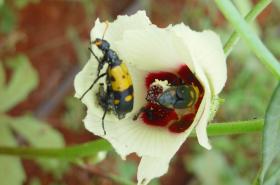
Flower beetle feeding on okra flower
© A.M. Varela, icipe

Flower bee…

Blister be…
Bugs: Cotton stainers (Dysdercus spp.)
Several species of bugs attack okra. Some of them occur from the early stages of the crop, but are more common during the mature stages, feeding on developing pods. Their feeding causes small, dark, raised blister-like spots on pods.
These bugs are very common on okra plants at the fruiting stage. They are conspicuously red with black bands. Both adults and nymphs feed on developing pods and seeds, piercing them to suck sap, thereby reducing yield. Attacked young fruits shrivel and then dry. Feeding on mature fruits results in damage to the seeds. Stainers also attack cotton and they live on baobab and silk cotton (kapok) trees.
Stainer bugs are between 14 and 24 mm long.
- Plough deeply or hoe to expose the eggs.
- Uproot all plants after harvesting and destroy wild alternate hosts.
- Custard apple leaf extract is recommended for control of these bugs (PAN).
- Preventive control measures are sanitation; remove plants and all its debris as soon as harvesting is over. Keep stores clean. Hand pick and destroy the bugs, this is feasible in small plots and at the beginning of infestations, and will help to reduce population density.
- Caging chickens in cotton plots using chicken wire may control cotton stainers; about 15 birds will keep about 0.1 ha free of stainer bugs. This is a good option for small plots grown next to the homestead.
- Cotton stainers are attacked by a range of natural enemies; the most important are assassin bugs, ants, spiders, birds and parasitic flies.
- The baobab tree is one of the main host plants of stainer bugs. If cotton is grown where baobab occurs, the soil and trunk of the baobab tree should be sprayed with biopesticides to kill the nymphs hatching from eggs laid around the stem.
- Tanzania: Pyrethrum formulation is used with black wattle extract as UV light stabiliser
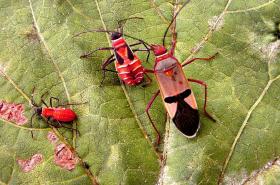
Cotton stainers (Dysdercus spp.). Nymphs (two to the left) and adult cotton stainer. Stainer bugs are 14-24 mm long.
© A.M. Varela, icipe
Bugs: Stink bugs (Nezara viridula, Atelocera sp. and Halydicoris sp.)
Both adults and nymphs of the stink bugs feed on buds, blossoms, pods and seeds. They are 6-15mm long. Their feeding causes local necrosis resulting in small pimples on the pod, and occasionally pod shedding. On very young pods, it causes twisting and distortion of pods, rendering them unmarketable.
Stink bugs are a minor pest and normally do not justify any control. But they can be a problem at podding.
- If necessary, spray botanicals in the morning when nymphs and adults bask on the plant canopy. Neem based pesticides reportedly reduce feeding by sting bugs. For more information on neem click here. A number of other plants (lantana, garlic, oleander, African marigold, blackjack, goat weed, wormseed, among others) are reported as effective against various species of bugs (Elwell and Maas, 1995). Pyrethrins are recommended for control of bugs in organic production in USA (Layton, 2004).
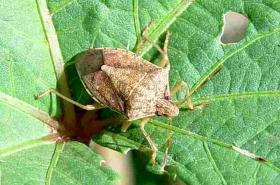
Brown stink bug (Halydicoris sp.) on okra. Real size: 6 to 15 mm long.
© A. M. Varela
Damping-off diseases (Pythium spp., Rhizoctonia solani)
Damping-off diseases affect the initial establishment of a crop. Their main features include poor emergence and death of seedlings leading to poor stands in seedbeds and fields. Seeds may rot before germination. Affected seedlings that have emerged from the soil show water-soaking, browning and shrivelling of the stem at the soil level. They eventually fall over and die. Damping-off diseases are favoured by excessive wetness of the soil and low soil temperatures.
- Use certified disease-free seeds
- Avoid over-irrigation and excessive fertilisation with nitrogen fertilisers.
- Avoid fields previously planted with cotton or other related crops.
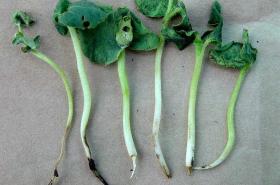
Okra seedlings affected by damping-off (Pythium spp., Rhizoctonia solani)
© A.A. Seif & A.M. Varela, icipe
Early blight (Alternaria solani)
Leaf spots of early blight are circular, up to 12 mm in diameter, brown, and often show a circular pattern, which distinguishes this disease from other leaf spots on tomato.
- Use resistant varieties (e.g. "Rio Grande").
- Use certified disease-free seeds. If using own seeds, hot water treat the seeds. For more information on hot water treatment click here.
- Use disease-free plants.
- Do not plant plant consecutively tomato crops on the same land.
- Practise rotation with non-solanaceous crops (e.g. brassicas, legumes, small grains).
- Stake and prune indeterminate varieties.
- If disease is endemic, applied preventative sprays of copper compounds (e.g. copper hydroxide).
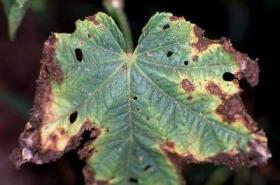
Early blight symptoms on okra leaf.
© M. Rutherford/CABI BioScience. Reproduced from the Crop Protection Compendium, 2004 Edition. CAB International, Wallingford.
Fusarium wilt (Fusarium oxysporum f.sp.vasinfectum)
This fungus is seed- and soil-borne. Diseased plants are stunted. Leaves of diseased plants turn yellow, wilt and later are shed. Usually the lower leaves are first affected. When a stem or main root of diseased plant is cut crosswise, brown discolouration is usually found in the ring just beneath the bark. Wilting of plants is mostly gradual. Water stress, warm soil temperatures, acidic soils and high content of nitrogen in the soil favour the disease. Infestation by root-knot nematodes aggravates Fusarium wilt.
- Use certified disease-free seeds.
- Treat seeds with a biopesticide preparation of Trichoderma viride (commercially available in Kenya).
- Control root-knot nematodes.
- Practise regular irrigation.
- Control weeds.
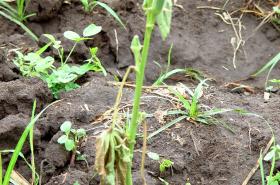
Wilting of okra plant due to Fusarium wilt (Fusarium oxysporum f.sp.vasinfectum)
© A.M. Varela & A.A.Seif, icipe
Powdery mildew (Leveillula taurica / Oidiopsis taurica)
The disease is characterised by a white coating resembling a fine talcum powder on lower and upper leaf surfaces. The white coating is the fungal growth. Severe infection causes the affected leaves to roll upward and eventually scorching. The disease also attacks stems, flower buds and okra pods. Infection occurs when humidity is in the range of 52 to 75% and air temperatures are around 26 to 27°C.
- Practise field sanitation.
- Do not grow okra or related crops like cotton in succession.
- Use sulphur based fungicides (in conventional production) or sulphur (in organic production).
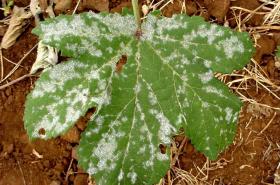
Powdery mildew on upper surface of okra leaf.
© A. M. Varela, icipe

Powdery mi…

Powdery mi…
Bacterial blight ( Xanthomonas campestris p.v. malvacearum)
The bacterium is transmitted through seed and water splash. Symptoms consist of spots on leaves and pods. Leaf spots are initially soaked with water and are more obvious on the underside of leaves. They are restricted to the veins and are angular in shape. Spots on petioles are elongated, sometimes slightly sunken and blackish. Spots on pods are initially water-soaked and round. Later, they join together and turn oily black. All spots appear waxy and shiny.
- Use certified disease-free seeds.
- Avoid overhead irrigation.
- Avoid working in the field when wet.
- Remove crop debris after harvest.
- Spray with copper-based fungicides. For more information on copper-based fungicides click here.
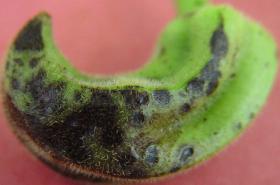
Bacterial blight ( Xanthomonas campestris p.v. malvacearum) on young okra pod
© A.A. Seif & A.M. Varela, icipe

Bacterial …

Bacterial …
Black mould (Cercospora abelmoschi)
Black mould can be serious in humid warm areas. It causes leaf spots of various shapes. It grows as a sooty to dark oily (olivaceous) mould on the underside of leaves, but when infection is severe and conditions are very humid it also appears on upper surface of infected leaves. Seriously infected foliage rolls, wilts and falls to the ground.
- Avoid overlap of okra in the same field.
- Rotate with baby corn, maize, small grains or pulses.
- Avoid overhead irrigation.
- Use copper prays. For more information on copper sprays, click here.
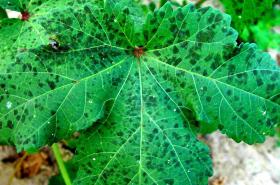
Black mould (Cercospora abelmoschi) leaf spots on the top side of an okra leaf
© A.A. Seif & A.M. Varela, icipe
- AIC (2003). Fruits and Vegetable Technical Handbook. Nairobi
- CAB International (2005). Crop Protection Compendium, 2005 Edition. Wallingford, UK www.cabi.org
- Critchley, B. R. (1995). Manual for the Integrated Pest Management of diseases, insects, nematodes and weeds of garden egg, okra, onion, peppers, and tomato in Brong Ahafo, Ghana. Natural Resources Institute (NRI). UK
- East African Seed Co. Ltd. Africa's Best Grower's Guide www.easeed.com
- Elwell, H, Maas, A. (1995). Natural Pest & Disease Control. Natural Farming network, Zimbabwe. The Plant Protection Improvement Programme and The Natural Farming Network.
- Frances Michaels (2006). Strategies for organic grasshopper control. www.greenharvest.com
- Hill, D. (1983). Agricultural insect pests of the tropics and their control. 2nd edition. Cambridge
- Layton, B. (2004). Bug-wise. No. 18. August 5, 2004 Office: 1-662-325-2085. www.msucares.com
- Lost Crops of Africa: Volume II: Vegetables (2006). NATIONAL RESEARCH COUNCIL Division on Policy and Global Affairs Development, Security, and Cooperation. Free online-version available: National Academies Press: www.nap.edu
- Malenge, F. K. (2005). Evaluation of efficacy and the cost effectiveness of selected synthetic insecticides, neem products and border crops in management of aphids (Aphis gossypii) in okra (Albelmochus esculentus) fields in Kenya. Master thesis. Department of Crop Protection, Faculty of Agriculture. University of Nairobi.
- Nutrition Data www.nutritiondata.com.
- Varela, A.M., Seif, A. (2004). A Guide to IPM and Hygiene Standards in Okra Production in Kenya. ICIPE, Kenya. ISBN: 92 9064 161 5
- Youdeowei, A. (2002). Integrated pest management practices for the production of vegetables. Ministry of Agriculture (MOFA) Plant Protection and Regulatory Services Directorate (PPRSD), Ghana, and German Development Cooperation (GTZ). ISBN: 9988-0-1088-5